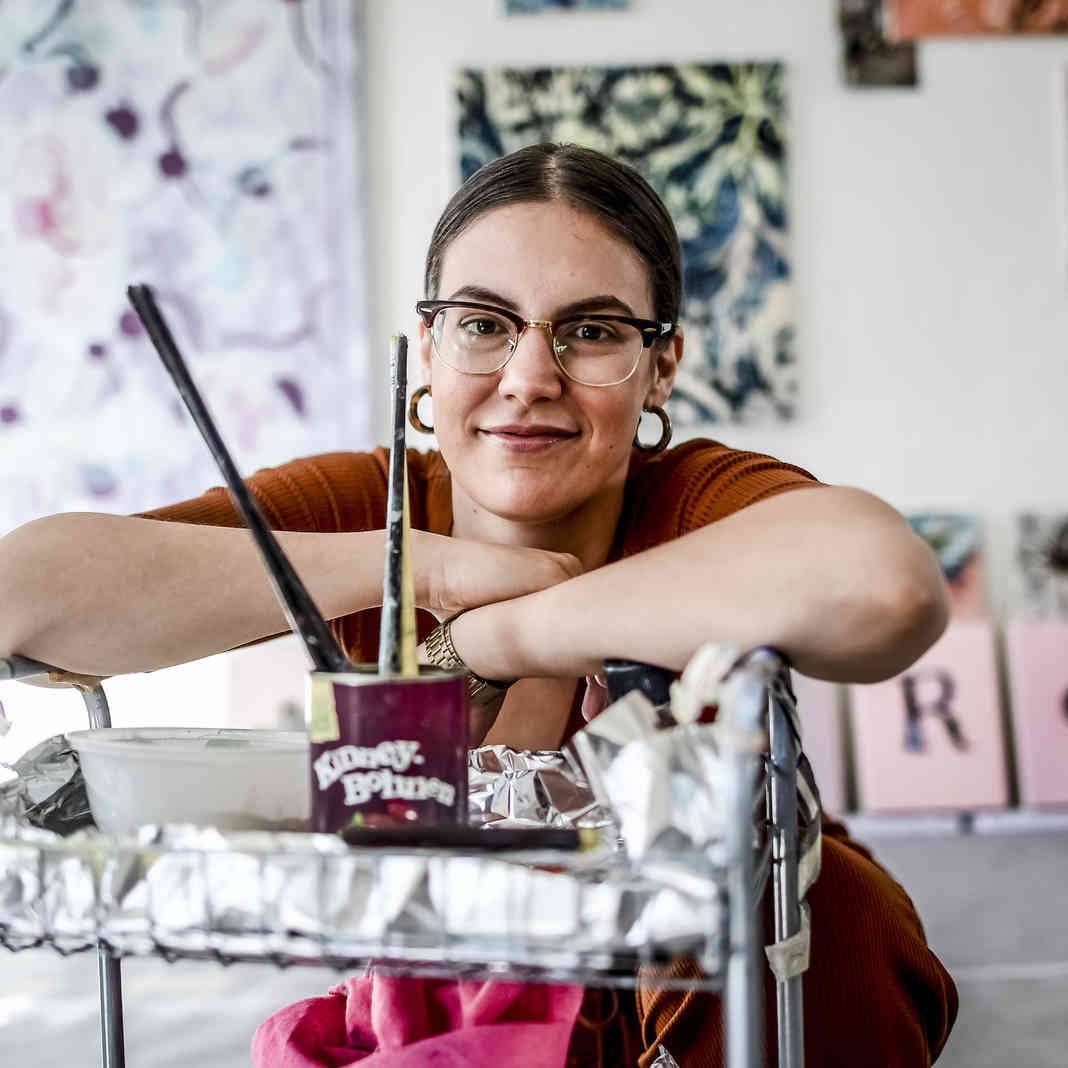We have spoken to Dora about the impact of the award on her development and the thematic background of her work
Unlike many other art prizes, the ARTPIQER's Painting Award is a very open prize that includes everything a young artist desires. Often art prizes are only linked to a residency without additional monetary support. For me, the combination of a solo exhibition, the prize money and the residency was perfect because the prize money allows the artist to work without any financial pressure.
At the Grand Award Opening at Werthalle in Cologne. From left to right: Jury member Dr. Barbara J. Scheuermann (Kunstmuseum Bonn), Oliver Struch (Founder Wertheim Cologne), Dora Celentano, Janine Wixforth (ARTPIQ), Katharina Wenzel-Vollenbroich (Founder ARTPIQ)
2. Among others you have won a residency at PADA Studios in Lissabon, a 5.000€ cash prize as well as a solo exhibition at Werthalle in Cologne. How do you think these prizes will support you in the next year?
With the prize money and the residency, I can concentrate more on my art and work with more focus on projects. Through the residency I get to know international artists and a country that will be very inspiring.
3. What do you think is the biggest obstacle for young artists in their early development?
That is a difficult question. But I think the challenge is to stay with you. You constantly compare yourself to other artists and think that you have to do it like that in order to be seen as well. In fact, there is no formular to be an artist and therefore it is important to find your own way.
4. Could you let us know a bit more about the thematic background of your exhibition "Beyond Painting" at Werthalle?
My work is about things that we consider beautiful and how our eyes are shaped by beauty. It deals with accumulation and collecting, as well as a nonsensical order, which occur visually in the patterns and rhythmic arrangements. In the exhibition, I try to make this clear by the composition of the artworks and the hanging.
Installation shot of Dora Celentano's exhibition "Beyond Painting" at Werthalle in Cologne. Photograph by Kai Werner Schmidt.
5. Would you say that your work is a direct critique of consumerism? Or do you think the desire to accumulate things and possession is somehow also profoundly human and therefore inevitable?
Both. My mother comes from a time of the new german economic boom after World War II. My dad comes from a large family from Italy where it has always been financially difficult. The contrast between ownership and want is something that runs like a thread in my family history. The contrast between the two extremes is what concerns me in my work. I think it's important to surround yourself with beautiful things. At the same time, I always get an oppressive feeling when amassing too much in my private life or looking at the effects of our consumer-driven society.
6. Where do you think your interest in fashion and advertisement originates? Were there specific experiences that sparked your fascination?
In my youth, I have always been very interested in fashion magazines like Vogue, Elle, etc. For hours I could look at photo spreads and get lost in it. Often, I glued together collages from parts of these magazines, as an envelope for poetry albums. As I got older, I came to study communication design. During this study I realized several magazine ideas but also an alternative fashion label, called "GELD" which was founded together with the photographer Heike Kandalowski. There we sewn 10 € vouchers in special packaging and sold them for 10,99 €. At some point it became clear that my interests were not in the design process, but in an artistic exploration of the subject. That's why I decided to study painting at the Kunstakademie Düsseldorf. In my Professor Stefan Kürten I found someone who deals with very similar topics, the so-called "perfect world“.
Installation shot of Dora Celentano's exhibition "Beyond Painting" at Werthalle in Cologne. Photograph by Kai Werner Schmidt.
7. What do you find specifically interesting about the "translation" of the digital into analogue creative processes? Nowadays one usually witnesses more of the opposite happening.
Things that I see in the digital context are in a vacuum, without context and in a never-ending flow of images. By painting these objects from the Internet, I end this flow, letting the object filter through my body into reality, and give it permanence through the painterly process.
8. Do you have an idea where your creative practice will lead you towards in future?
I’d like to work even more with habitat creation and experiment with different materials. For example, a work is planned with the adhesive sheets that I usually used as a stencil form for murals.
9. Who is your artistic role model and why?
It's hard for me to call an artistic role model, but I immediately think of two important sources of inspiration: Umberto Eco’s piece „Name of the rose“ is a historical murder mistery with a combination of semiotics and fiction, medevial studies and literary theory. I liked the idea of archiving and disfunction of orders in this masterpiece.
Another big influence is music, because Im also a DJane and dancer. I really like big operas with syntethis of the arts like Turandot from Giaccomo Puccini.
10. If you were to paint a self portrait - which colours and forms would dominate the picture?
Somehow all my pictures are self-portraits. So I guess purple and floral ornaments would dominate the picture.


